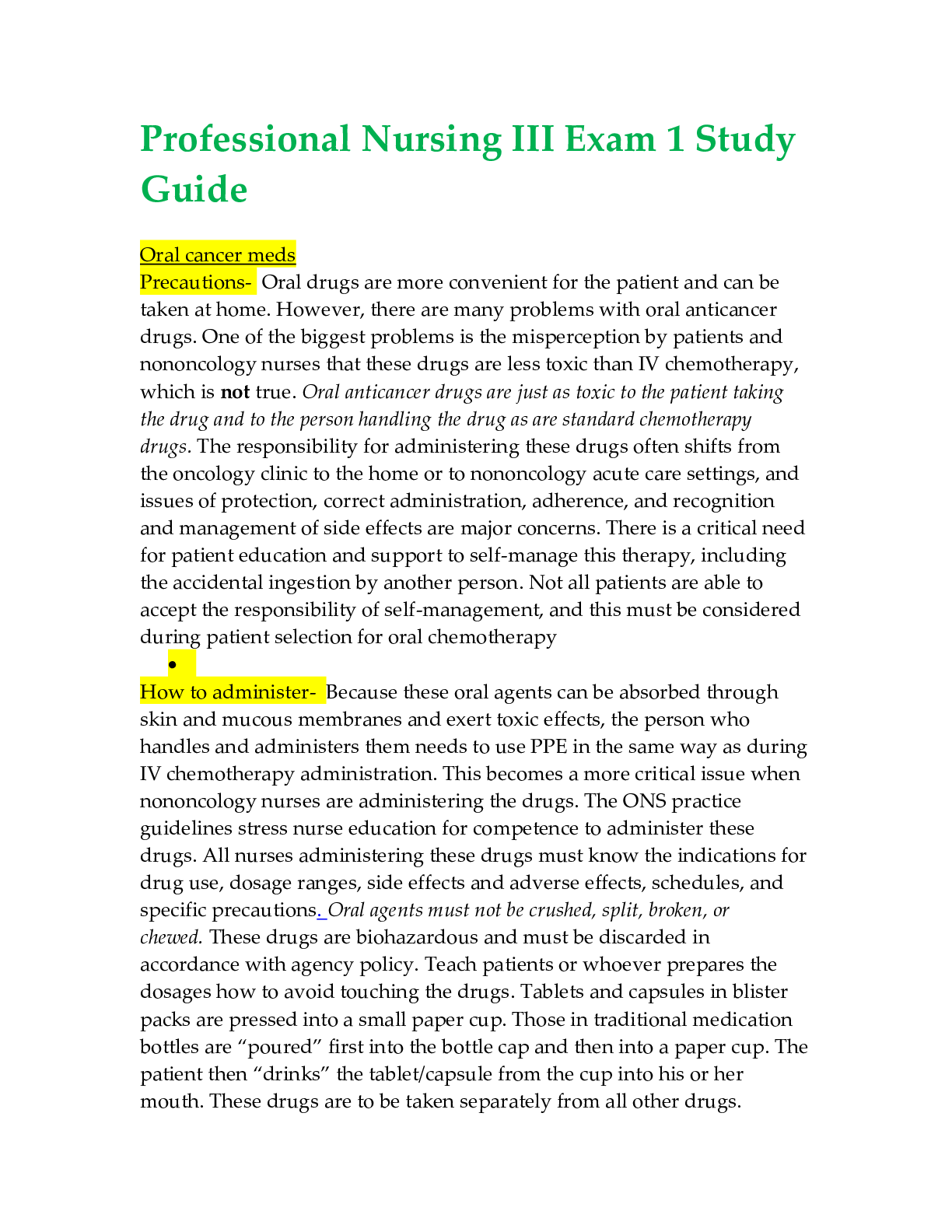Anatomy and Physiology - A&P 2 > STUDY GUIDE > A&P 2 Exam 1 Study Guide. (All)
A&P 2 Exam 1 Study Guide.
Document Content and Description Below
A&P 2 Exam 1 Study Guide Blood (1) Circulatory System – heart, blood vessels, and blood Cardiovascular System – heart and blood vessels Functions of Circulatory System: • Transport syste... m for – O2, CO2, nutrients, wastes, hormones, stem cells • Protection from – inflammation, infection, etc. • Regulation – fluid balance, stabilizes pH of ECF, temp control Blood • Connective tissue that has 2 types of cells (RBC and WBC), not tightly compounded together • 4-6 L of blood circulating in 1 min for adults • Plasma – matrix of blood, clear/yellow fluid after taking everything out • Formed elements – blood cells and cell fragments (RBC, WBC, platelets) • Use centrifuge to separate plasma from formed elements of blood (hematocrit) o RBC on bottom, buffy coat in b/w (WBC/platelets), and then plasma on top o Check glucose but not diagnostic tool b/c plasma clumps together in disc Plasma & Plasma Proteins • Plasma – liquid portion of blood o Serum – remaining fluid when blood clots and solids are removed • 3 major categories: o Albumin – smallest and most abundant ▪ Contributes to viscosity, influences BP o Globulins (antibodies) – WBC ▪ Provide immune system functions ▪ Alpha, beta, gamma globulins o Fibrinogen – precursor of fibrin threads that help from blood clots ▪ Inactive until needed, fibrin threads • Plasma proteins formed by lived (except globulins – formed by WBCs) General Properties • Erythrocytes – RBC o RBC carry O2 (hemoglobin) from lungs to tissues and pick up CO2 from tissues to bring back to lungs o Will move single file thru capillaries o Lose all organelles when mature to allow for aerobic respiration • Platelets – cell fragments from special cell in bone marrow • Leukocytes – WBC o Granulocytes (w/ granules/grains) ▪ Neutrophils – “first responders”, 1st to arrive at site of potential problem (infection) ▪ Eosinophils – difficult to find, several jobs – active in parasitic infections, helps clean up antibodies attacking foreign invaders ▪ Basophils – works w/ neutrophil, releases histamine – vasodilator – expanding the vessel locally where the cut it, constricts but everything else vasodilates o Agranulocytes (w/o granules) ▪ Lymphocytes – main cells that produce antibodies, give immunity ▪ Monocytes – biggest of WBC, macrophages, clean up waste products and debris after lymphocytes do their job, only ones that leave bloodstream Hemoglobin • Consists of 4 protein chains (globins) and 4 heme groups • Heme groups – nonprotein that binds O2 to iron at its center • Globins – 2 alpha + 2 beta = 4 protein chains Erythrocytes Death & Disposal • RBCs lyse in narrow channels in spleen • Survive about 120 days – do not die just wear out Anemia • Iron-deficiency o Lack of inadequate iron in diet • Pernicious o Vitamin B12 deficiency Blood (2) Blood Types • Based on interactions b/w antigens and antibodies • Antigens – complex molecules on surface of cell membrane that are unique to the individual o Used to distinguish self from foreign antigens which generate an immune response o Agglutinogens – antigens on surface of RBC that is the basis for typing blood • Antibodies – proteins secreted by plasma cells o Part of immune response to foreign matter o Bind to antigens and mark them from destruction o Found in plasma o Anti-A and anti-B • Antigens – A & B o Determined by carb found on RBC surface o Type O – lack antigens • ABO Group o AB – universal receiver ▪ Lacks plasma antibodies; no anti-A or B o O – universal donor ▪ Lacks RBC antigens ▪ Donor’s plasma may have both antibodies against recipient’s RBC (anit-A and anti-B) • Rh Group o Gives positive or negative type o 1st pregnancy doesn’t matter, 2nd does Hemostasis • Cessation of bleeding, blood clotting 1. Stopping potentially fatal leaks 2. Hemorrhage 3. Mechanisms: Vascular spasm, platelet plug formation, blood clotting Platelets • Small fragments of megakaryocyte cells • Aid in blood clotting • 3-4 Step Method: 1. blood vessel punctured 2. Platelets form plug 3. Damage a tissue – release diff tissue factors “alarm system” something went wrong ▪ One will active (prothrombin activator is released) inactive protein that’s always there ▪ Prothrombin activator + calcium makes it to thrombin + calcium fibrinogen fibrin threads (protein fiber) Stem Cells • Erythroblasts RBC • WBC lymphocytes o Monoblasts monocytes o Myeloblasts neutrophils, eosinophils, basophils • Megakaryoblasts platelets (thrombocytes) Heart (1) Cardiovascular System Circuit Left Side (Systemic Circuit): • Fully oxygenated blood arrives from lungs via pulmonary veins • Blood sent to all organs of the body via aorta Right Side (Pulmonary Circuit): • Lesser oxygenated blood arrives from inferior and superior vena cava • Blood sent to lungs via pulmonary trunk which picks up O2 Heart Valves • Valves prevent backflow • AV valves – controls blood flow b/w atria and ventricles o Right AV valves has 3 cusps (TRIcuspid valve) o Left AV valve has 2 cusps (mitral or BIcuspid) o Chordae tendinae - cords connect AV valves to papillary muscles on floor of ventricles ▪ Prevent AV valves from flipping inside out or bulging into the atria when the ventricles contract • Semilunar valves - control flow into great arteries – open and close because of blood flow and pressure o Pulmonary semilunar valve - in opening between right ventricle and pulmonary trunk o Aortic semilunar valve in opening between left ventricle and aorta Blood Flow • Superior/inferior vena cavas right atrium bicuspid valve right ventricle pulmonary valve pulmonary artery/trunk lungs, picks up O2 pulmonary veins left atrium bicuspid/mitral valve left ventricle aortic valve aorta body Cardiac Muscle – fast-acting, involuntary control • Bound together by intercalated discs • Gap junctions – little channels b/w 2 or more cells for rapid communication Cardiac Conduction System • Conduction system – how does it regulate/transmit nervous impulses that make heart beat (cardiac cycle) • Start in right atrium w/ SA node (pacemaker) – highly specialized tissue, act as neuron, has an intrinsic rhythm – can pull heart out and cut strings but still sets pace o Normal HR – 70 bpm / helps set pace o Pacemaker takes signal from nervous system o Signal spreads passively w/ “no hard wire”, no nerves/neurons thru right atrium across to left atrium • Have gap junctions to be able to send signal across from atriums • Cardiac impulse in right atrium and left atrium (superior heart) • Left atrium pushing blood to left ventricle • AV node – b/w right atrium/right ventricle, has “hard wires” (AV bundle/Purkinje fibers – highly specialized pieces of cardiac muscle) • Passive spreading thru gap junctions thru atrium is enough (cardiac muscle is thinner) o Not for ventricles b/c thicker muscle • AV node fires ventricles Cardiac Rhythm • Systole – atrial/ventricular contraction • Diastole – atrial/ventricular relaxation • Sinus Rhythm – normal heartbeat triggered by the SA node o Set by SA node, 60-100 bpm (makes it faster) o Adult at rest is 70-80 bpm (vagal tone) ▪ Cranial nerve 10 – vagus ▪ Parasympathetic stimulator – slow it down • Ectopic focus – another part of the heart fire before SA node o Caused by hypoxia, electrolyte imbalance, or caffeine, nicotine and other drugs SA Node Potentials • Action potential from cells inside SA node • HR controlled below the threshold line – slow Na+ channels until you hit the threshold which opens up rapid Na+ and Ca+ channels (voltage-gated channels) • K+ helps go back to zero – ALWAYS • Once you hit threshold – “all or none” – once it gets to the number, rapid channels opened and cannot stop o Parasympathetic/sympathetic – control w/ slow sodium channels Action Potential of a Cardiocyte 1. Na+ gates open 2. Rapid depolarization 3. Na+ gates close 4. Slow Ca+ channels open o Ca+ forms plateau so cardiac muscle cell can sustain contraction long enough to get forceful push of blood thru 5. Ca+ channels close, K+ channels (repolarization) ECG/EKG • Composite of all action potentials of nodal and myocardial cells detected, amplified and recorded by electrodes on arms, legs and chest • Normal cardiac cycle/heartbeat – 3 distinct waves o Starts in P wave – represent atrial contraction (systole), not a strong wave o Millivolts – force o QRS wave – or complex – represents ventricular contraction (mostly left ventricle) valves prevent backflow o When atria contract the ventricles are relaxed – so while at atrial systole, at ventricular diastole o T wave – all four chambers at state of diastole, has a little bit of electricity, doesn’t represent any contraction ▪ Resting before pushing ions back ▪ Although at rest it’s where most of the blood actually move o Peak to peak is about 0.8 sec • Represents the graphical output of cardiac muscle the electrical output when cardiac muscle contracts, indirect measure ECG Deflections • P wave – SA node fires, atria depolarize and contract o Atrial systole begins 100 milisec after SA signal • QRS complex – ventricular depolarization o Complex shape of spike due to different thickness and shape of the 2 ventricles • ST segment – ventricular systole o Plateau in myocardial action potential • T wave – ventricular repolarization and relaxation Electrical Activity of Myocardium 1. Atrial depolarization begins 2. Atrial depolarization complete (atria contracted) 3. Ventricles begin to depolarize at apex; atria repolarize (atria relaxed) 4. Ventricular depolarization complete (ventricles contracted) 5. Ventricles begin to depolarize at apex 6. Ventricular repolarization complete (ventricles relaxed) • Wave of contraction is the same as flow of blood Nerve Supply to Heart • Even though they do opposite things they still want the same thing – homeostatic balance • Sym and parasym always checking each other Sympathetic nerves (raise HR) • Fibers terminate in SA and AV nodes, in atrial and ventricular myocardium, as well as the aorta, pulmonary trunk, and coronary arteries • Shortens the time it takes to get to threshold o Increase HR and contraction strength o Dilates coronary arteries to increase myocardial blood flow Parasympathetic nerves (slows HR) • Fibers of right vagus nerve lead to the SA node (cranial nerve 10) • Fibers of left vagus nerve lead to the AV node • Little or no vagal stimulation of the myocardium o Reduces HR o “Little or no” tells us there is variation in population • Lengthens the time it takes to get to threshold Chronotropic Effects of Automatic Nervous System • Sympathetic postganglionic fibers are adrenergic o Release norepinephrine/adrenaline o Binds to beta-adrenergic fibers in the hear o Activates c-AMP second messenger system in cardiocytes and nodal cells o Leads to opening of Ca+ channels in plasma membrane o Increase Ca+ inflow accelerated depolarization of SA node o cAMP accelerates the uptake of Ca2+ by the sarcoplasmic reticulum allowing the cardiocytes to relax more quickly o By accelerating both contraction and relaxation, norepinephrine and cAMP increase the heart rate as high as 230 bpm o Diastole becomes too brief for adequate filling o Both stroke volume and cardiac output are reduced o Beta-blockers – lower BP o Increase Ca+ flow – increase HR o Norepinephrine increases this Ca+ flow Autonomic Receptors • A1 receptors = increase in Ca+ o Cause contraction of smooth muscle • A2 receptors = decrease in cAMP o Cause contraction of smooth muscle • B1 receptors = increase in cAMP o Increase contraction (heart SV and HR) • B2 receptors = increase in cAMP o Relax smooth muscle Excitatory Adrenergic Synapse • This is how norepinephrine (neurotransmitter) talks to SA node in cardiac muscle by using beta1 receptors • Norepinephrine meets receptor which shoots off G protein • Adenylate cyclase – enzyme Chronotropic Chemicals • Chemicals affect HR as well as neurotransmitters from cardiac nerves o Blood born adrenal catecholamines (NE and epinephrine) are potent cardiac stimulants • Drugs that stimulate heart o Nicotine stimulates NE and EPI secretion increase HR o Thyroid hormone increases # of adrenergic receptors on heart so more responsive to sympathetic stimulation ▪ Ultimate metabolic stimulant, increases productivity of receptors and makes them work better o Caffeine inhibits cAMP breakdown prolonging adrenergic effect ▪ Keeps Ca+ channels open more Effects on ANS • Parasympathetic vagus nerves have cholinergic, inhibitory effects on the SA and AV nodes o Ach binds to muscarinic receptors o Opens K+ gates in the nodal cells o As K+ leaves the cells, they become hyperpolarized and fireless frequently o HR slows down • Vagal tone – steady background firing rate of vagus nerves • ACh is excitatory to skeletal muscle, it is inhibitory to cardiac muscle. The difference is the different receptor • It meets muscarinic receptors and opens potassium gates • Increase K+ slows the heart down by keeping it at rest a little longer • Na+ to threshold, Na+ & Ca+ inside cell then K out of the cell • Muscarinic ACh receptors require the mediation of g-proteins o Built to accept Ach meets receptor causes g protein to fire off from receptor to open up an ion channel opens up a K channel to keep at rest longer = slower Inputs to Cardiac Center • Cardiac centers in the medulla receive input from many sources and integrate it into the decision to speed up or slow the heart • Higher brain centers after the HR o Cerebral cortex, limbic system, hypothalamus – sensory or emotional stimuli • Medulla also receives input from muscles, joints, arteries, and brainstem o Proprioceptors in the muscles and joints o Baroreceptors signal cardiac center o Chemoreceptors ECGs: Normal & Abnormal • Abnormalities – MI, heart enlargement, electrolyte imbalances • Nodal Rhythm – no SA node activity • Pressure gradient before the atria contracts, the gradient pushes a fair amount of blood into the ventricles anyway. Atrial contraction just finishes the job • Ventricular tachycardia/fibrillation o Ventricles are moving so fast/firing off so quickly it completely obscures the rest of the EKG ▪ Eradicates the ventricle contraction – can’t tell if its contracting, this could happen w/ illicit chemicals – caffeine ▪ T wave is obscured AV blocks • SA node controls P wave • AV block still has 1:1:1 ratio, still could be sinus rhythm, T wave is inverted, and QRS isn’t as big as it should be • T wave represents cleaning up of ventricles • 1st degree AV block: for some reason the AV node isn’t getting the right signal, the signal is bad getting there, or once it gets there it isn’t sent out, AV node controls QRS wave • 2nd degree AV block: only getting one ventricular contraction per 2 ventricular contractions, not sinus rhythm, not 1:1:1, too many P waves, too few QRS • 3rd degree AV block: no one number/ration, multiple Ps for every QRS, ventricles are working but not at full capacity, same QRS wave you’d see after heart attack/MI, QRS doesn’t look quite right • May have chemical imbalances (Na, Ca, K), or problems with SA or AV node Heart Sounds • First heart sound (S1) – louder and longer, “lubb” occurs with closure of AV valves, turbulence in the bloodstream, and movements of the heart wall • Second heart sound (S2), softer and sharper “dupp” occurs with closure of semilunar valves, turbulence in the bloodstream, and movements of the heart wall o AV valves – tricuspid and bicuspid valve o Semilunar valves – pulmonic and aortic valve o Heart murmur – any irregularity Major Events of Cardiac Cycle • The ventricles are never completely empty • Never completely empty air out of lungs or else they’d collapse; ventricles would do the same thing • 60mL of blood is lowest volume of blood in the ventricles = “empty” • T wave is longest wave, majority of blood flow occurs here when everyone else (P and QRS) is relaxed • àBlood moving from atria into ventricles by way of pressure gradient, not expending energy, high to low • àRed indicates where atrial pressure gets higher than ventricles • àBlood moving into ventricles after P wave • End diastole volume = max volume of ventricles, completely full after resting • àT wave • End diastolic volume: ventricles are lowest here at the end of contraction Volume Changes • End-systolic volume – 60 ml • Passively added to ventricle during atrial diastole – 30+ ml • Added by atrial systole – +40ml • Total – end-diastolic volume – 130 ml • Stroke volume ejected by ventricular systole – -70ml • Leaves – end-systolic volume – 60 ml • Both ventricles must eject same amount of blood • Stroke volume = amount of blood pushed out of ventricles per beat Heart (3) Cardiac Output • Amount ejected by ventricle in 1 min • CO = HR x stroke volume • 4-6 L/min at rest HR • Pulse – surge of pressure produced by each heart beat that can be felt by palpating a superficial artery w/ fingertips o Infants have HR of 120 bpm > • Tachycardia – resting adult HR above 100 bpm • Bradycardia – resting adult HR of less than 60 bpm • Positive/negative chronotropic agents – raise or lower HR Cardiac Output Regulation • Parasympathetic – decreases HR decreases cardiac output o Can only operate HR, not contraction • Sympathetic – increases HR increases CO (increases strength of contraction) o Can operate both HR and contraction • HR & CO directly inverted o Increase and decrease strength of contraction in the ventricle and able to push w/ more force Venous Return & End-diastolic volume • What contributes to putting more blood into heart? (end diastolic vol – ventricles filled) • Urine vol contributes to blood vol which contriutes to venous return à end diastolic vol • Inside cell, outside cell, in blood plasma and in digestive tract are places you can have fluid in cell • If you don’t urinate, blood vol increases b/c more water is in blood, vice versa • Kidneys contribute to end-diastolic vol. controls where water goes • Tissue volume (icf, ecf) – losing water • More put back into heart – higher the end diastolic vol • Thoracic pressure pump – breathing contributes to end diastolic vol • Sympathetic stimulation - increases BP, and venous pressure and venous return Cardiac Muscle • Skeletal muscle generates force and so does cardiac muscle but not the same • Motor unit – 1 neuron and how many skeletal muscle fibers it talks to • Need more strength – recruit more muscle fibers in same bicep to lift heavier object and generates more force • Cardiac muscle either contracts or it doesn’t • W/ every beat every cardiac muscle cell contracts, contributes to the generation of force • Sarcomere sites can change which can change the size of the contraction Law of the Heart • “Rubber ball” – the more its stretched, the harder and faster its snapped back therefore generating a bigger force. More blood put in the more it stretches • More put in ventricles the more it puts out CHF • Results form the failure of either ventricle to eject blood effectively o Usually due to a heart weakened by MI, chronic hypertension, valvular insufficiency, congenital defects in heart structure • Left ventricular failure – blood backs up into the lungs causing pulmonary edema o SOB or sense of suffocation • Right ventricular failure – blood backs up I the vena cava causing systemic or generalized edema o Enlargement of the liver, ascites, distension of jugular vein, swelling of the fingers, ankles and feet • Eventually leads to total heart failure [Show More]
Last updated: 1 year ago
Preview 1 out of 11 pages
Instant download
.png)
Buy this document to get the full access instantly
Instant Download Access after purchase
Add to cartInstant download
Reviews( 0 )
Document information
Connected school, study & course
About the document
Uploaded On
Jun 15, 2022
Number of pages
11
Written in
Additional information
This document has been written for:
Uploaded
Jun 15, 2022
Downloads
0
Views
83











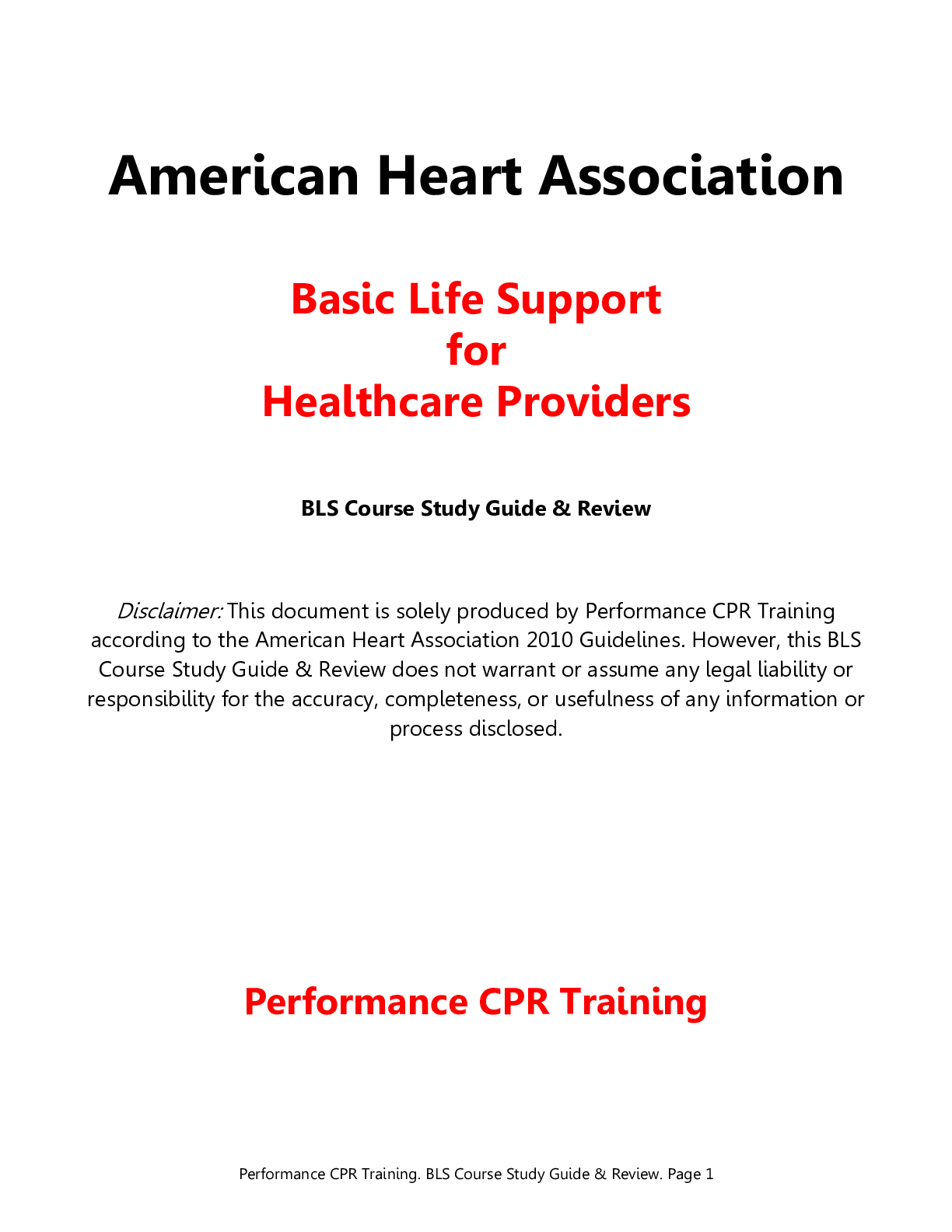
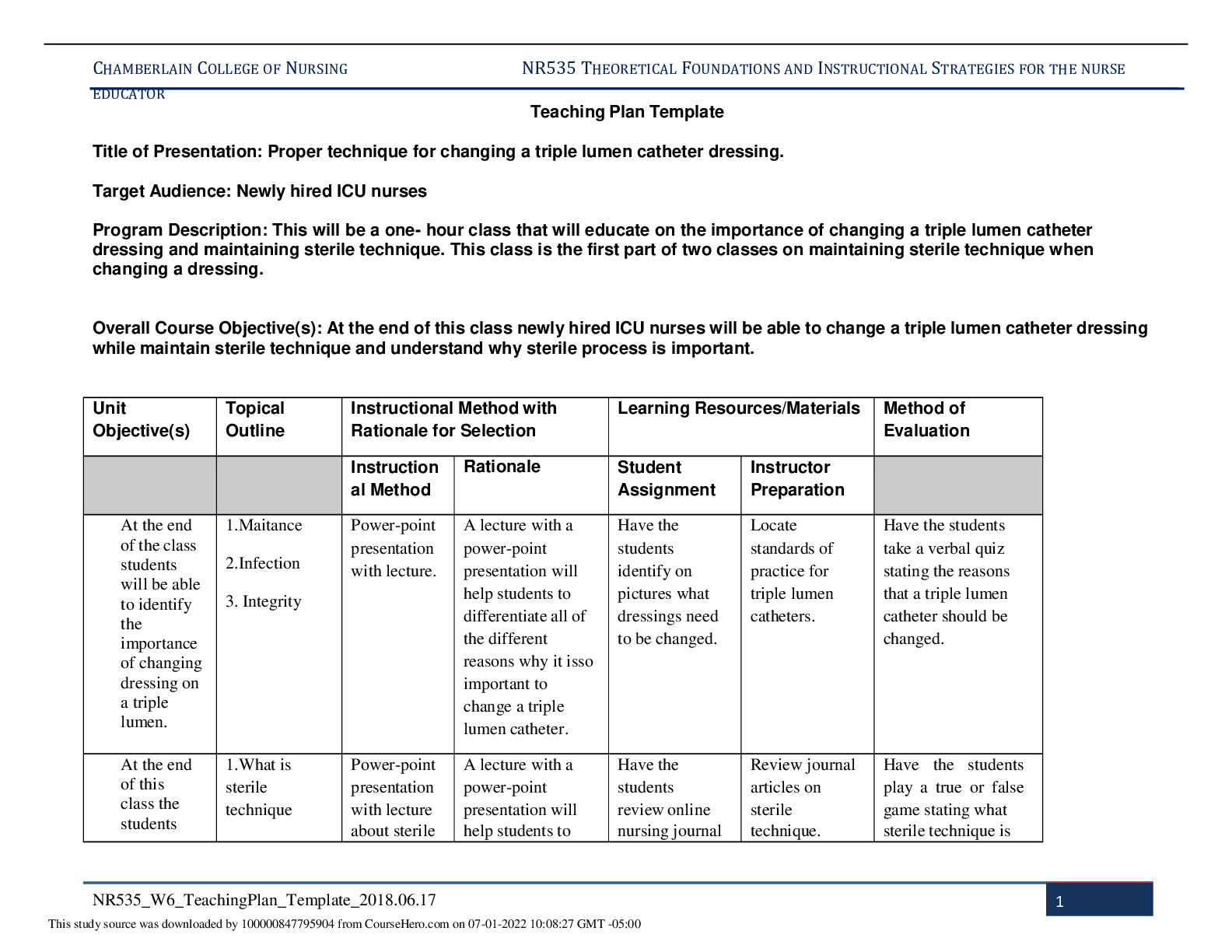
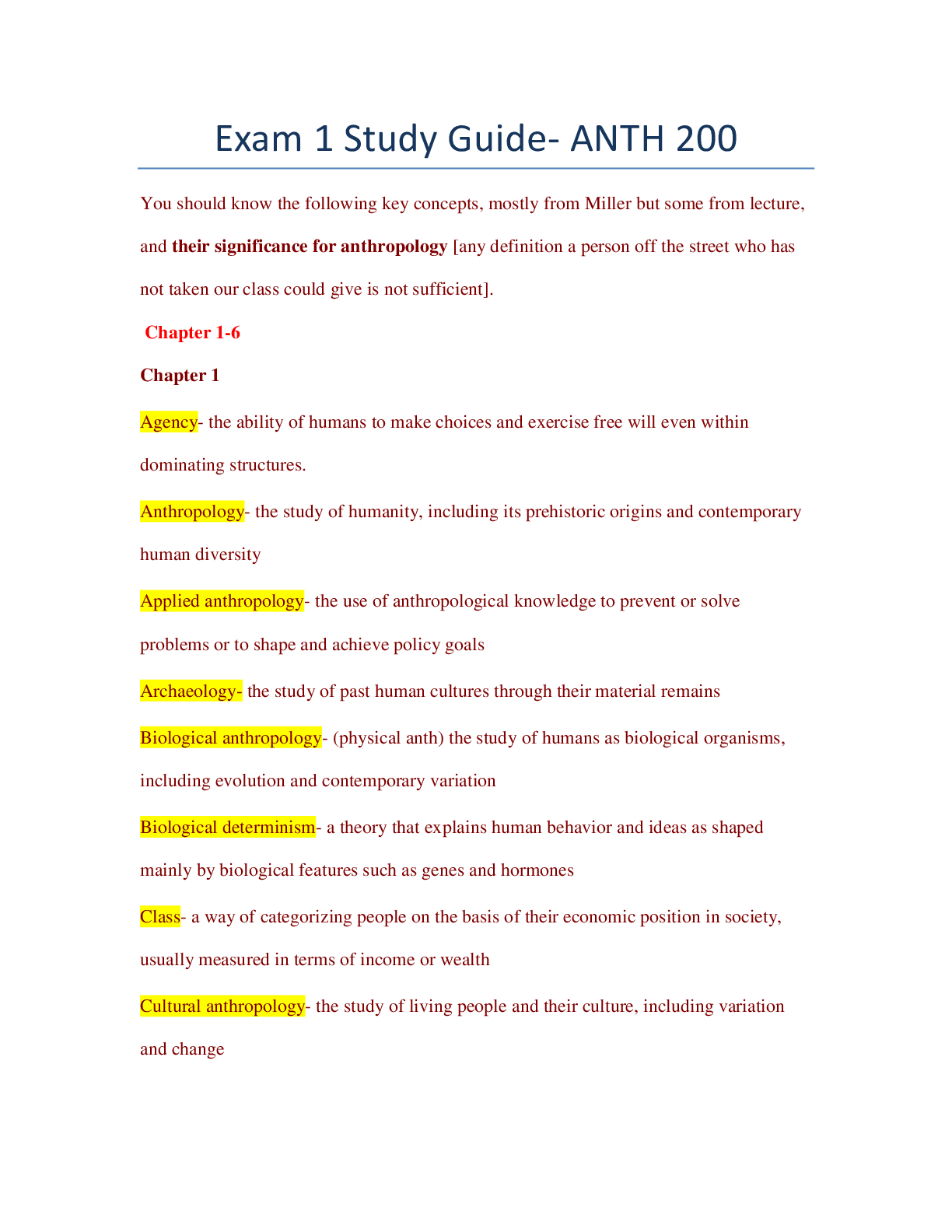
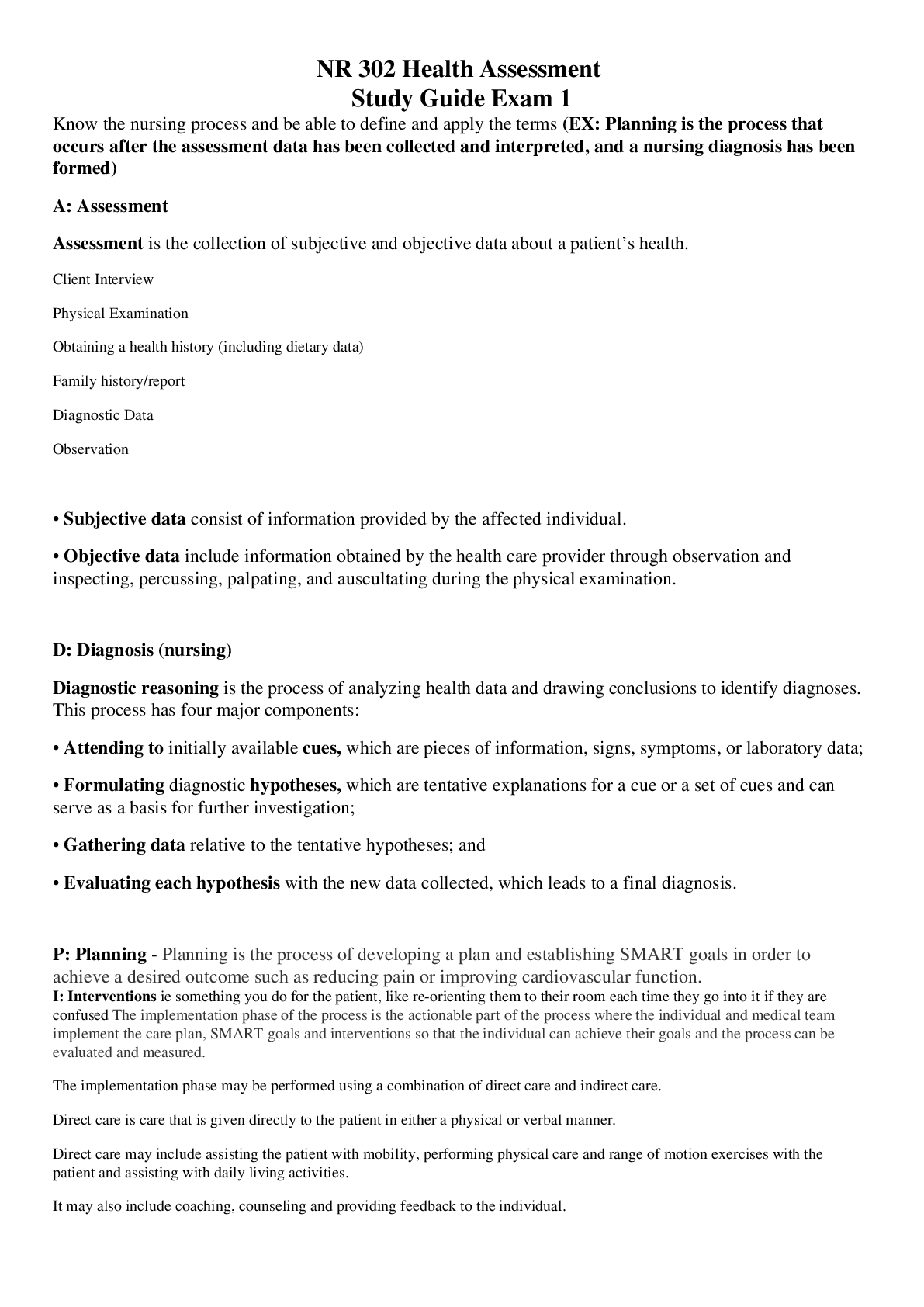





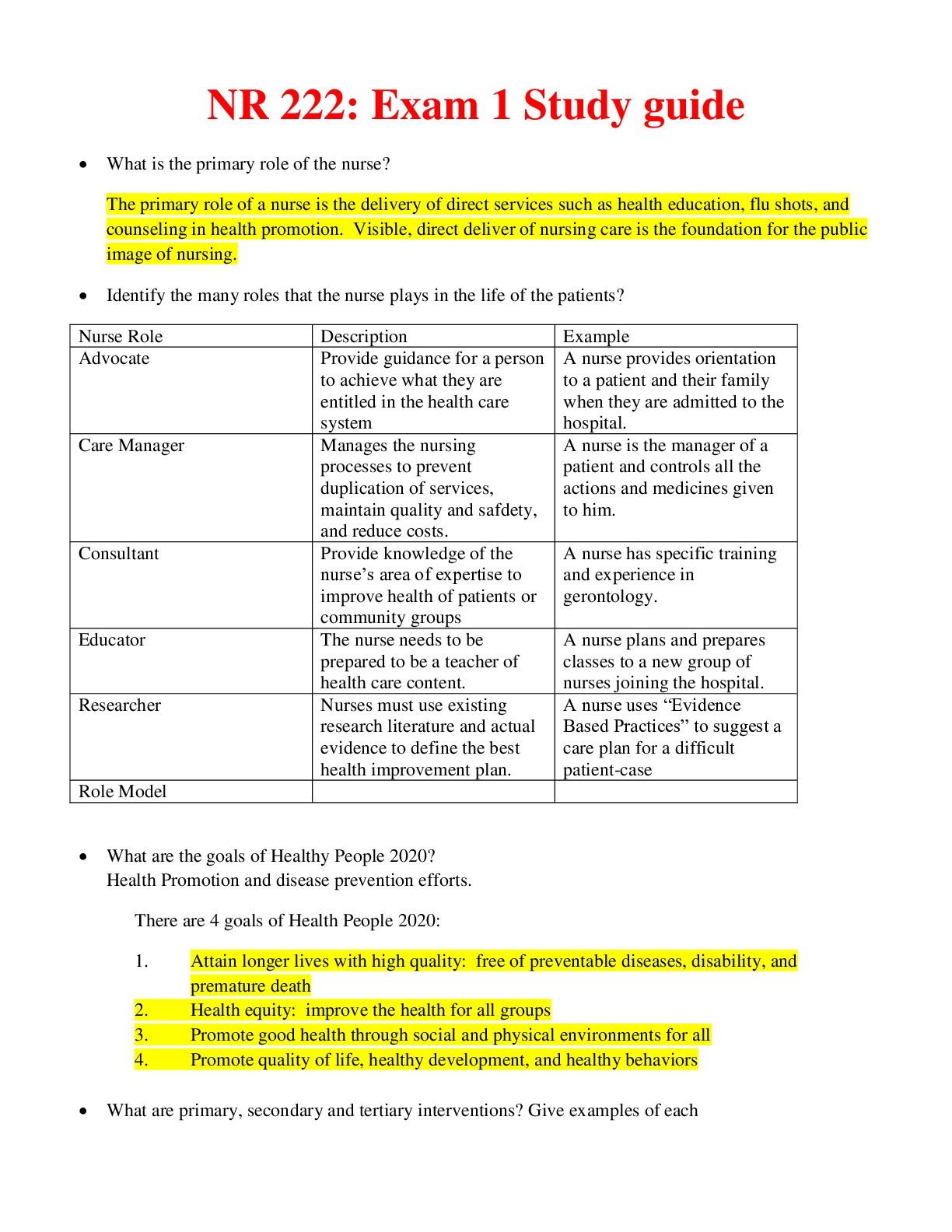


.png)
